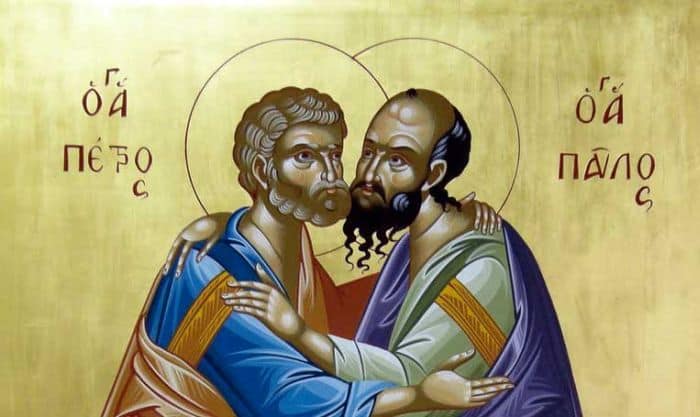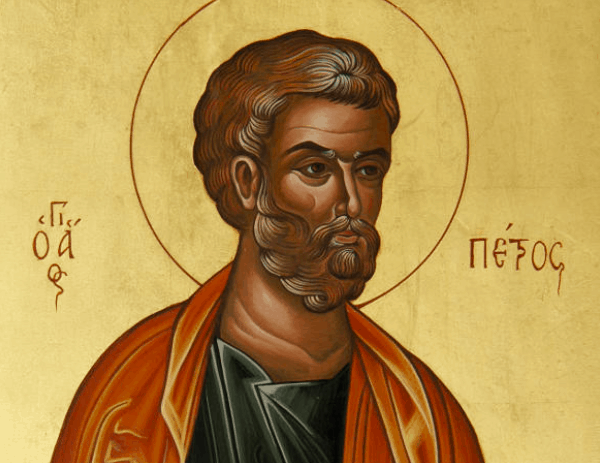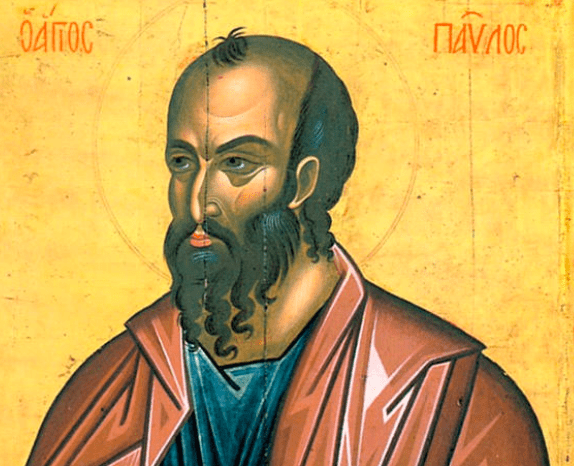On the 29th of June, the Greek Orthodox Church celebrates the feast day of Agios Petros and Agios Pavlos.

So important is this celebration in the Orthodox Church that it is marked by a preparatory fasting period – called the fast of the apostles – beginning from the Monday after Pentecost and lasting until the eve of the feast day of Agios Petros and Pavlos.
Following the practice of the early Church, where the first Christians would commemorate departed saints by celebrating the Divine Eucharist on top of their tombs, we, too, nearly two thousand years later, follow that same tradition. We, too, continue to celebrate the feast days of saints by celebrating the Divine Liturgy over the altar of the Church of the particular saint to which the Church is dedicated. The reason for this is that the altar of every Church is said to be symbolic of saints’ tombs in that every consecrated Church has relics of saints within the altar.
If you are wondering why these two apostles, in particular, are celebrated on the same day, Petros was one of the twelve, whereas Pavlos was not. Petros' ministerial outlook was very different from Pavlos' from the Biblical evidence. At the council of Jerusalem (48AD), great problems had arisen in the Church from a large influx of Gentile converts, and these saints had different opinions on how they should be received. Yet we find that not only are they celebrated on the same day, but even icons of Agios Petros and Pavlos portray these two major apostles embracing each other.
Historically, the Church combined the feast day of the two apostles into one because they were both martyred in Rome on the same day. A very ancient tradition claims that they were executed during Nero’s persecution approximately in the year 68 AD. For this reason, probably from the fourth century onwards, the Church in Rome came to celebrate the feast day of these two apostles on the 29th of June when they were martyred. By contrast, Constantinople celebrated this feast day several days after Christmas on the 28th of December. However, we see that the Roman custom has prevailed in the Church today, but the evidence does not reveal precisely when this came to be.
Theologically speaking, the feast day of these two apostles was combined into one to show that even though their ministerial vision was not the same, both were necessary and even complemented each other.
In regards to the Saints themselves:

Peter was the son of Jonah and the brother of Andrew the First-called. He was of the tribe of Simeon, from the town of Bethsaida. He was a fisherman and was at first called Simon, but the Lord was pleased to call him Cephas, or Peter (John 1:42). He was the first of the disciples to clearly express faith in the Lord Jesus, saying: Thou art the Christ, the Son of the Living God (Matthew 16:16). His love for the Lord was great, and his faith in the Lord became gradually stronger. When the Lord was brought to trial, Peter denied Him three times; but after only one glance into the face of the Lord, Peter’s soul was filled with shame and repentance. After the descent of the Holy Spirit, Peter showed himself to be a fearless and powerful preacher of the Gospel. Following one of his sermons in Jerusalem, three thousand souls were converted to the Faith. He preached the Gospel in Palestine, Asia Minor, Illyria and Italy. Peter worked many powerful miracles: he healed the sick and resurrected the dead, and the sick were healed even from his shadow. He had a great struggle with Simon the Magician, who proclaimed himself to be a god, but who was, in reality, a servant of Satan. Peter finally shamed and defeated him. By order of Simon’s friend, the evil Emperor Nero, Peter was condemned to death. Having consecrated Linus Bishop of Rome and having counselled and comforted the flock of Christ, Peter proceeded joyfully to his death. Seeing the cross before him, he begged his executioners to crucify him upside down, for he considered himself unworthy to die as had his Lord. Thus, this great servant of the Great Lord reposed and received a wreath of eternal glory.

Paul was born in Tarsus and was of the tribe of Benjamin. At first, he was called Saul. He studied under Gamaliel and was a Pharisee and a persecutor of Christianity. He was miraculously converted to the Christian Faith by the Lord Himself, Who appeared to him on the road to Damascus. He was baptized by the Apostle Ananias, named Paul and numbered in the service of the Great Apostles. With fiery zeal, Paul preached the Gospel everywhere, from the borders of Arabia to Spain, among the Jews and among the Gentiles, and received the title “the Apostle to the Gentiles.” As horrible as his sufferings were, so much greater was his superhuman patience. Throughout all the years of his preaching, Paul hung from day to day as on a weak thread between life and death. Having filled all his days and nights with labour and suffering for Christ, having organized the Church in many places, and having attained such a degree of perfection, he was able to say: not I, but Christ liveth in me (Galatians 2:20). Paul was beheaded in Rome during the reign of Emperor Nero, at the same time as the martyrdom of the Apostle Peter.
Today is also the name day of Pavlos, Pavlina, Paul, Paulina, Petros, Petroula, Petra, Pavlikos, Poulikos, Petras, Petrakis, Petrinos.
Xronia Polla!
